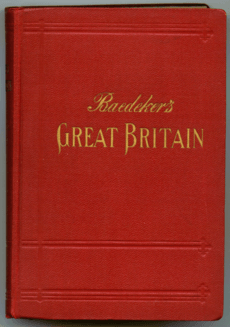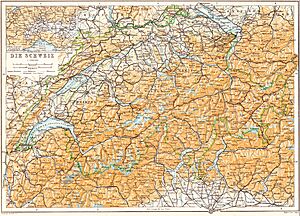Baedeker facts for kids
Verlag Karl Baedeker is a famous German company that makes travel guides. It was started by Karl Baedeker on July 1, 1827. These guides, often just called "Baedekers", were pioneers in helping people explore the world.
Baedeker guides usually include maps and introductions to places. They also give information about travel routes, transportation, and places to stay. You can find descriptions of important buildings, sights, and museums, often written by experts.
Contents
History: The Early Years (1827-1948)
Karl Baedeker: The Founder
Karl Baedeker (1801–1859) came from a family of printers and publishers in Essen, Germany. He was the oldest of ten children. In 1827, Karl left his family's business to start his own in Koblenz. Around 1850, he changed his family name's spelling from Bädeker to Baedeker.
In 1832, Baedeker's company bought another publishing house. This company had published a travel handbook called A Rhine Journey from Mainz to Cologne. Karl Baedeker decided to create a new version of this book. He added many of his own ideas about what a travel guide should offer.
Baedeker wanted travelers to find all the information they needed in one book. This included details about routes, transport, hotels, restaurants, and sights. While other travel guides existed, Baedeker was special because he included very detailed information about travel and places to stay.
Karl Baedeker had three sons: Ernst, Karl, and Fritz. Each of them would later lead the company.
Ernst Baedeker: Taking the Helm
After Karl Baedeker passed away in 1859, his oldest son, Ernst Baedeker (1833−1861), took over. Ernst had studied bookselling in Germany and worked in London. He joined his father's company in 1859 and became its head just ten months later.
During his time, the first Baedeker travel guide in English was published in 1861. It was a handbook about "The Rhine" river. He also published new guides in German and French about Italy. Sadly, Ernst Baedeker died unexpectedly in 1861. His younger brother, Karl, then took charge.
Karl Baedeker II: Expanding the Guides
Karl Baedeker II (1837−1911) continued his brother Ernst's work from 1861 to 1877. He oversaw the updates of existing guides and published 14 new ones. These new guides were in German, English, and French.
Some of the new English guides included Switzerland (1863), Paris (1865), and guides for different parts of Italy. Karl Baedeker II worked with his younger brother Fritz, who joined the company in 1869. In 1877, Karl became ill and could no longer work, so Fritz took over.
Fritz Baedeker: The Golden Age of Guides
Fritz Baedeker (1844−1925) led the company from 1869 to 1925, a time of great growth. In 1872, he moved the company's main office from Koblenz to Leipzig. This was a big step, as many important German publishers were in Leipzig.
Fritz also convinced Eduard Wagner, a mapmaker, to move to Leipzig. Wagner started a new company called "Wagner and Debes" right next to Baedeker's office. This new company made amazing maps and detailed plans of palaces, churches, and museums for the guides. These maps were known for being the best in the world.
The company grew very quickly. Fritz started publishing guides for places outside Europe, like Russia, Egypt, the USA, Canada, and India. This period was known as the "golden age" of Baedeker travel guides. The guides became so popular that "baedekering" became a term for traveling to write a guide or travel story.
Fritz had three sons—Hans, Ernst, and Dietrich—who worked with him. His fourth son, Karl Baedeker III, became a physics professor but was killed in action in August 1914. His son, Karl Friedrich, would later restart the company after the Second World War.
Fritz produced 73 new "Baedekers" during his more than 50 years in charge. He became the most successful travel guide publisher ever. In 1909, Leipzig University gave him an honorary Ph.D.
However, World War I caused problems for the company. Tourism dropped, and people around the world felt anti-German. This led to a decline for Baedeker. After the war, in 1920, Baedeker guides for German cities started to include some advertising, which was a new thing for them.
Hans Baedeker: Tough Times and War
Hans Baedeker (1874−1959), Fritz's oldest son, took over in 1925 during very difficult times. His brothers, Ernst and Dietrich, helped him. The company had lost a lot of money after World War I. Tourism was down, and anti-German feelings hurt sales, especially in America and France. High inflation also made things worse.
The Great Depression in the 1930s stopped any hope of quick recovery. Then, the rise of Nazism made things even harder for tourism. The worst hit came on December 4, 1943, when the British Royal Air Force bombed Leipzig. Baedeker's headquarters were completely destroyed, and all their old records were lost.
Hans was very proud of his family's achievements and tried hard to keep the company going. He got a loan from a London publisher and continued to produce guides. In 1927, he celebrated the company's 100th anniversary. He managed to publish 12 new German guides and 5 new English ones, even some ordered by the Nazi government.
The Nazis checked Baedeker guides and made changes to the text. They even decided who could buy certain guides. For example, Baedeker was asked to publish a guide for the German Army in Poland, with history written the way the Nazis wanted.
In 1948, the guide for Leipzig was the first Baedeker published after World War II. It was also the last one published in Leipzig, which was now under Russian control. The Russians didn't want Baedeker to publish. Hans found a way to print 10,000 copies, but after about 1,000 were sold, the Russians said the guide had military secrets (a map showing their headquarters) and took the rest.
History: Modern Era (since 1948)
Karl Friedrich Baedeker: Rebuilding the Brand
Karl Friedrich Baedeker (1910−1979) was the grandson of Fritz Baedeker. He had worked as an editor before World War II. After the war, he was a prisoner of war and later worked in local government. In 1948, he decided to restart the family publishing business, calling it Karl Baedeker. His uncle Hans stayed in Leipzig, but Karl Friedrich could use his uncle's experience.
Other publishers tried to buy the "Baedeker" name, which was still famous worldwide. But Karl Friedrich refused to sell. He felt it was a family company and wanted to keep it that way.
In December 1949, he published his first new guide, Schleswig-Holstein. It was printed near Hamburg and included some advertising to help with costs. A London publisher also helped with another loan.
In 1951, Karl Friedrich made a deal with Shell AG and a German printer named Kurt Mair. They created a series of motoring guides called Baedekers Shell Guides. These slim guides were designed to fit in a jacket pocket or car glove compartment. They were very successful, first covering Germany, then other European countries.
Karl Friedrich worked on two types of guides: city and regional guides from his office, and the motoring guides. In 1954, he published a Berlin guide in German, English, and French, which helped re-establish the Baedeker brand. His son, Florian, and his cousin, Hans, also helped with the business.
In 1956, Karl Friedrich moved his operations to Freiburg im Breisgau.
Florian Baedeker: A Short but Important Time
Florian Baedeker (1943−1980), Karl Friedrich's only son, took over when his father died in 1979. Florian had studied in Munich and helped his father prepare the Munich guide for the 1972 Munich Olympic Games. He also worked on city guides for places like Baden-Baden and Strasbourg.
His guide for Basel, a Swiss city, published in 1978, is considered one of his best. Sadly, Florian Baedeker died in a parachuting accident on October 26, 1980, at age 36.
Eva Baedeker: The Last Family Member
After Florian's death, his mother, Eva Baedeker (1913−1984), led the company until she died in 1984. She was the last Baedeker family member to actively run the publishing house. Before she passed away, she arranged the sale of the Freiburg branch to Langenscheidt. However, the "Karl Baedeker" brand name has been kept by all later owners.
Allianz and Langenscheidt
Since 1979, Baedeker travel guides have been published with the German insurance group Allianz. These guides are colorful, have many pictures, and are in many languages. They cover most popular tourist spots worldwide. Over 150 guides have been published, and more are always being added.
In Britain, the guides worked with the British Automobile Association. In the USA, Macmillan Travel published them.
After Eva Baedeker died, the Freiburg Baedeker branch was bought by the German publisher Langenscheidt. In 1987, both Baedeker branches (Freiburg and Stuttgart) joined together as "Karl Baedeker GmbH". Langenscheidt and Mairs (the Stuttgart group) shared ownership.
MairDumont: A New Era
In 1997, Mairs Geographischer Verlag, now called MairDumont, became the full owner of Verlag Karl Baedeker. This meant they owned all rights to Karl Baedeker's name and company. The new English Baedekers stopped using the Allianz logo, and German editions did the same in 2013.
This marked a new look and content for modern Baedekers, with the slogan "Knowledge opens worlds." The new guides added a fifth section called "Experience and Enjoy." These new Baedeker guides were also the first to use infographics, which are pictures that show information.
Baedeker English Editions
From the very beginning, Karl Baedeker knew it was important to publish guides in English, not just German. His son Ernst, who had worked in London, was given the job of preparing the first English Baedeker. The Rhine guide came out in 1861.
James and Findlay Muirhead: Popularizing English Guides
The Scottish brothers James Francis Muirhead (1853−1934) and Findlay Muirhead (1860−1935) helped make the English guidebooks popular around the world. James became the editor of the English editions in 1879. Findlay later joined him as a co-editor. They were in charge of all English Baedeker editions for almost 40 years.
James Muirhead is credited with much of the content in the Canada guidebook, first published in 1894. The Canada guide is the only classic Baedeker that was published only in English.
James Muirhead also worked on The United States guide, first published in 1893. He traveled by boat, train, and horse to visit most of the areas described. He even added a trip to Mexico. The United States became a very impressive work, the first full guide to the country. It took James Muirhead two and a half years to research and write it. The fourth edition, published in 1909, also included trips to Cuba, Puerto Rico, and Alaska.
After World War I, Findlay started his own series of guides called the Blue Guides in London. His brother James joined him soon after.
Hermann Augustine Piehler: Continuing the Legacy
Hermann Augustine Piehler (1888−1987), known as H.A. Piehler, became the chief editor of the English editions after the Muirheads left. He was an Englishman of German background. Karl Friedrich Baedeker had lived with Piehler in London for a year when he was a student.
In 1948, when Karl Friedrich restarted the Baedeker company in Germany, Piehler, who was then a British intelligence officer, approved his publishing license. Piehler continued editing the English guides for many years. The Baedekers recognized the hard work of the Muirheads and Piehler and their important role in the success of Verlag Karl Baedeker.
See also
- Baedeker Blitz
- Karl Baedeker
- List of Baedeker Guides



